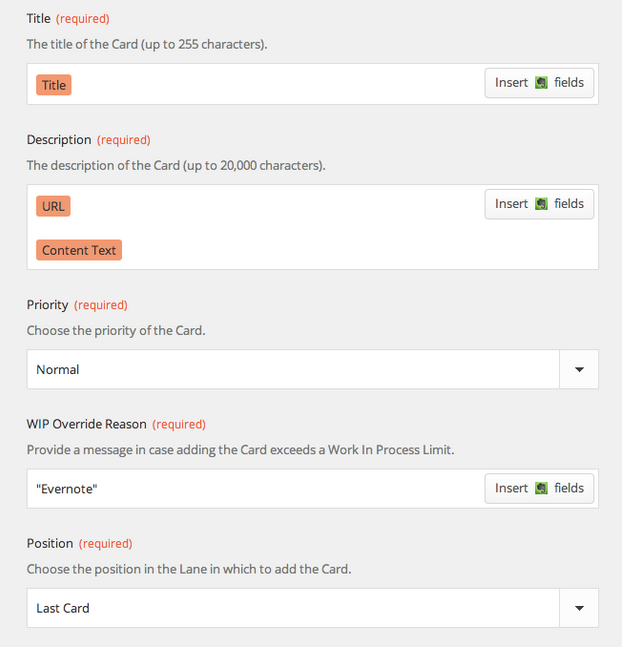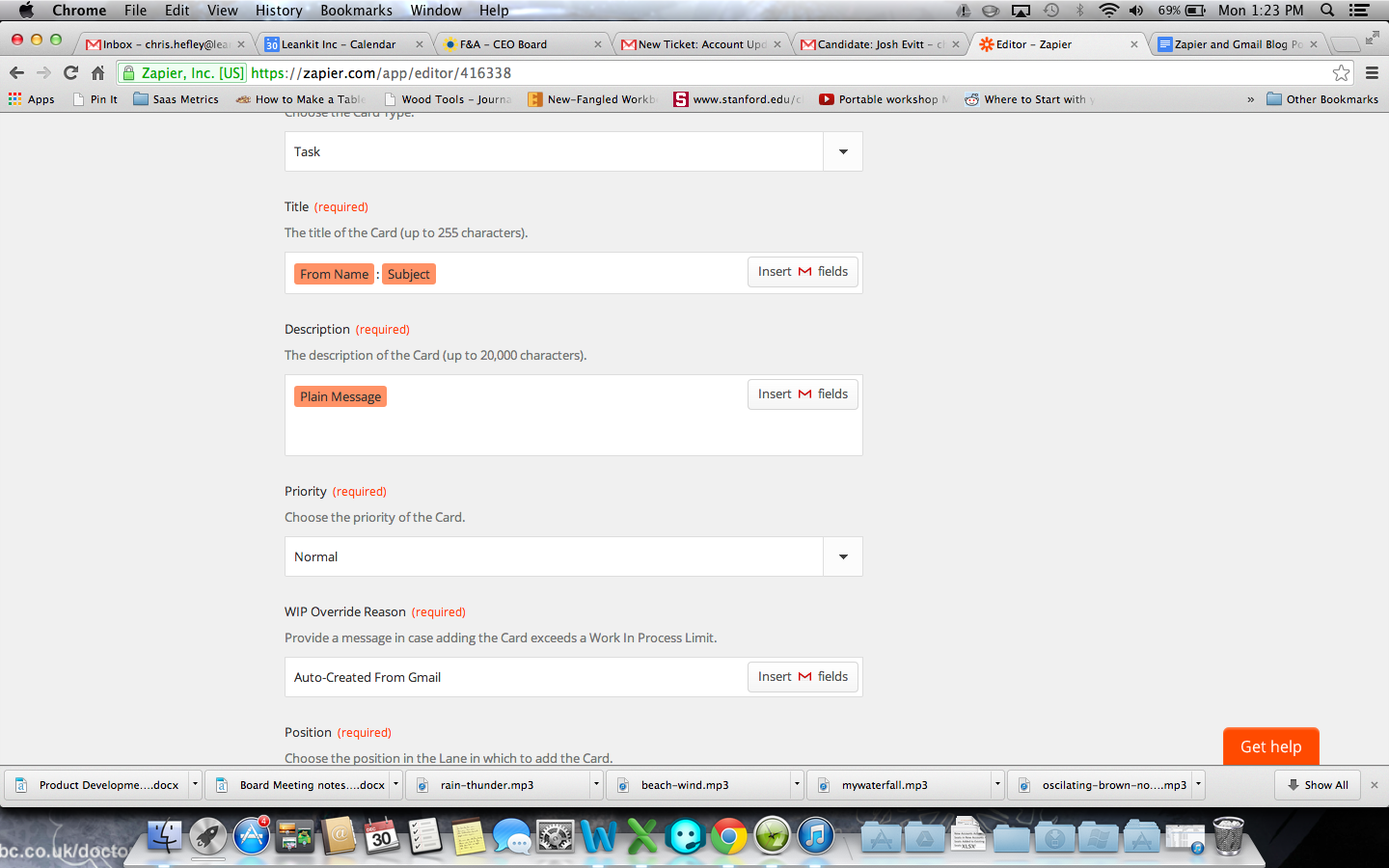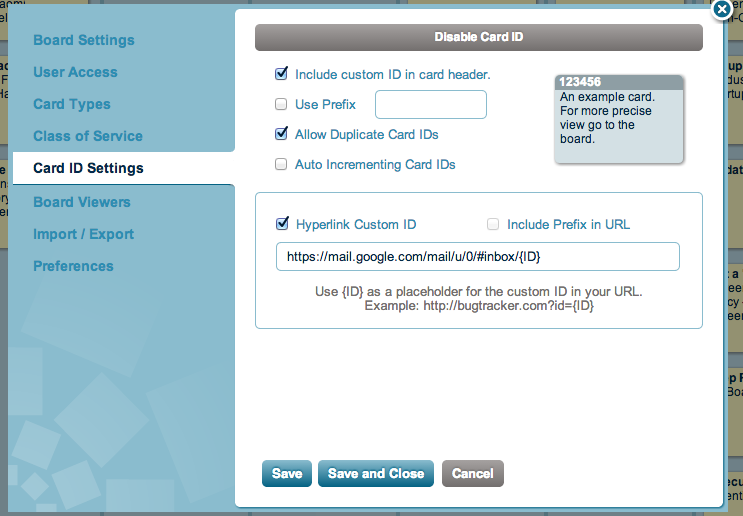First, you’ll need an account with Twilio, a popular programmable voice and SMS Service. Go to Twilio.com, and sign up for a new, free account.After you create your account, you’ll be asked for your phone number, and Twilio will send you a text message with a confirmation code, which you’ll need to enter on the next screen:Twilio will then generate a new phone number for your account:Now, open up Zapier.com, and log into your account, and create a new Zap, as shown below:Zapier will ask you to configure your Twilio account, using your Account SID and Auth Token from Twilio, shown below:Once you have set up your Twilio and LeanKit accounts correctly, you’ll see this:Select your Twilio number that you’ll send SMS messages to…And select the LeanKit board, lane, and card type. In the LeanKit “Title” (card title) field, choose “Body” from the list of available Twilio fields.Fill in the other required LeanKit fields:And finally, test and name your new Zap.You should now be able to text message your Twilio number (I created a contact in my iPhone for “LeanKit Twilio”, and a new LeanKit card will be created: This is the fifth post in the series by Chris Hefley of LeanKit showing how to integrate tools many of us use everyday with our Personal Kanban. You can read the previous post – Integrating Your Personal Kanban with Campfire in LeanKit using Zapier here.
Integrating Your Personal Kanban with Campfire in LeanKit using Zapier
Does your team use Campfire? Ever wish you could just create a LeanKit card from the Campfire chat window, just by typing in a simple command? This integration between Campfire and LeanKit, via Zapier.com, will let you do just that.
In your Zapier account, create a new Zap, using the Campfire “New Message” trigger and the LeanKit “New-Add Card” action.Zapier will prompt you to set up your Campfire account, and ask for your Campfire API token:Once you have your Campfire and LeanKit accounts set up correctly...…you’ll be able to configure your campfire trigger. I chose to set it so that if I type cflk (for “CampFire LeanKit) at the beginning of a message in Campfire, that will be the signal to create a LeanKit card from that message.Now I’ll go into my campfire room and type a message:And then set up the LeanKit side of my integration to point to my personal kanban board, target lane, and card type:I’ll set the Title, Description, and other required LeanKit fields:And then test the integration:I did have a little trouble at this step. If you’re using an existing campfire room and one of the first 3 messages doesn’t match your filter, Zapier isn’t pulling up a trigger sample that matches the filter for you to test with. In that case, I saved my Zap anyway, and then ran it manually from the Dashboard:And Viola! I have a LeanKit card reminding me to buy bacon. As if I would ever forget something that important. :)This is the fourth post in the series by Chris Hefley of LeanKit showing how to integrate tools many of us use everyday with our Personal Kanban. You can read the previous post – Personal Kanban: Integrating Evernote with LeanKit using Zapier here.
Personal Kanban: Integrating Evernote with LeanKit using Zapier
Continuing our series of Personal Kanban focused integrations for LeanKit, let’s take a look at integrating Evernote with LeanKit. Say you’re in Evernote, and you want to quickly add a card to your personal kanban board in LeanKit. With this integration, you can simply add “(LK)” to the note title, and BAM! LeanKit card.
As in our other integrations, we’re going to use Zapier.com to connect Evernote and LeanKit.Create a new “Zap” using the “New Note” trigger from Evernote with the “New -Add Card” action from LeanKit.Zapier will prompt you to authorize your Evernote account:After setting up your LeanKit and Evernote accounts,You can now configure the trigger for evernote. I chose to add a filter on the note title. In any notebook, I can add “(LK)” to the note title and have a LeanKit card created for that note. I could have chosen other options here, and you may decide you’d like it to work differently. For exaple, you could create a separate notebook in Evernote, and just have all notes from that notebook get added to LeanKit as cards. Or you could use the “tags” in evernote instead of the title, like I did.Now configure the LeanKit fields, including the Evernote Title in the LeanKit Card Title field.I also added the Evernote “URL” field to the LeanKit Description field, to provide me with a link back to the original note.So, to test this, create a new note in Evernote, with “(LK)” in the note Title:Then test and name the Zap you’ve created:And you should get a new LeanKit card, as shown below:You can also see the URL to the original note included in the description of the LeanKit card:Enjoy!This is the third post in the series by Chris Hefley of LeanKit showing how to integrate tools many of us use everyday with our Personal Kanban. You can read the previous post - Personal Kanban using Google Calendar, LeanKit and Zapier here.
Personal Kanban using Google Calendar, LeanKit and Zapier
This is the second post in the series by Chris Hefley of LeanKit showing how to integrate tools many of us use everyday with our Personal Kanban. You can read the first post - Killing Email Interruptions: Personal Kanban using LeanKit, Gmail and Zapier here.
This time, we’ll look at how to integrate Google Calendar with LeanKit via Zapier.com. We’ll look at two different ways to use Google Calendar and LeanKit together.
First, let’s create a “Zap” based on the Google Calendar “New Event Search” trigger. This will allow to create a Google Calendar event and a corresponding LeanKit card at the same time.Zapier will prompt you to set up your Google Calendar account and you can use your already set-up LeanKit account.After setting up the accounts, set the Search Term for the Google Calendar trigger. I used “(LK)”. If I create an event with “(LK)” in the title, this integration will create a LeanKit card for that event. That way, I can easily control which events from my calendar get a card.Now, I want to create a new card type on my LeanKit board, for “Event”.Now that we’ve taken care of that, we can set up the target LeanKit board, lane, and card type.Use the “Summary” field from the list of fields available from Google Calendar for the LeanKit Card Title field.Not all my calendar appointments actually have a description. Since Description is a required field in the LeanKit integration, add the “Summary” and “Event Begins (Pretty)” fields to the LeanKit Description field, in addition to the Google Calendar Description field, as shown below:We’re nearly ready to test the integration. First, though, let’s go to Google Calendar and create an event with “(LK)” in the event title:Finally, test and name the Zap:And you should get a new LeanKit “Event” card on your personal kanban board:There’s one other way I’d like to integrate my Google Calendar with LeanKit. I’d like to create a new card on my LeanKit board one day before a scheduled event, instead of immediately when I first create the event. So, if I’m using my personal kanban board to keep track of things I have to do on a given day, I will get the next day’s events added the the board each day.For this integration, I’m going to use the “Event Start” trigger from Google Calendar.When setting up the trigger parameters, I chose 1 day, and used the Search Term “(LKF)” (for “LeanKit Future”). The Search Term is optional, if you want this trigger to fire for all events.For the LeanKit parameters, set them up the same as in the previous example, then create a new Google Calendar event. The event needs to be in the future, within 24 hours of the current time in order for our test to work. And I’ve added “(LKF”) to the event title:Test and name this Zap:...and we should now have a new Event card on our LeanKit board:There you go! Now you can create a card and event at the same time, or mark a calendar event to have a LeanKit card created in the future, when the event is 1 day away.
Killing Email Interruptions: Personal Kanban using LeanKit, Gmail, and Zapier
Quick intro from Jim Benson:
We've asked Chris Hefley from Leankit to write a series of posts showing how to integrate tools many of us use everyday with our Personal Kanban. These are fairly technical posts, but also very powerful ones.
In this first post, Chris mentions that his aim is to keep his inbox at zero by taking action items and moving them directly to his Personal Kanban. Tonianne and I have also noticed that we also tend to act on emails the moment they arrive. This means that we allow email to interrupt our flow of work - then we get to the end of the day and are disappointed by how we let those interruptions derail our day.
Chris lays out a simple mechanism to move emails into your Leankit Personal Kanban that can both clean out your inbox and give some of those interruptions their proper priority. Also, I've turned Chris' post into a video which is at the bottom.
Take it away, Chris
-----------
I aspire to keep my inbox at zero. About once every couple of weeks, I actually get there. I’ve got several tools that I use to help me with that, including moving emails to my Personal Kanban board in LeanKit.
LeanKit has a connector available for Zapier, a cloud based integration hub. Zapier provides hundreds more connectors with other applications, which makes it very easy to connect LeanKit with Gmail, ZenDesk, BugZilla, BaseCamp, and many more.In this article, I’ll show you how to set up a “Zap” to create a LeanKit card based on an email in Gmail, complete with a link back to the original email, so that you can get that “to do” item onto your Kanban board and out of your inbox.First, you’ll need to go to Zapier.com and create an account. There’s a free account that should work just fine, and if you need more integrations or faster synchronization you can upgrade later.Once you’ve created your account, you’ll be asked to create your first “Zap”, and presented with the screen below:
On the Trigger (left) side, choose Gmail, and choose “New Thread”.
On the Action side (right side) choose LeanKit and “New-Add Card” for the action.So that when a new Thread is created in Gmail that fits the criteria we will add later, it will create a matching card in LeanKit.
Follow the steps in Zapier to set up your Gmail account:
…and your LeanKit account.
Now, in a separate browser tab, go into your gmail account, open an email, and create a Label called “lk” (or something similar) for that email. (Help for how to create a label in Gmail: https://support.google.com/mail/answer/118708?hl=en)
Back in Zapier, in the filter for your Gmail Trigger, choose the “lk” label you created in the previous step (it could take a few minutes for the label to show up after you’ve created it. If you don’t see it after a few minutes, try saving your “Zap” incomplete, and then coming back to this step.)
In Zapier, Choose the LeanKit board you’d like to add cards to. This will allow you to select from any board in your LeanKit account (that you have access to with your login).
After selecting the Board, you’ll be able to select the lane you want new cards added to, and the Card Type you want for your new cards.
For the Card Title field, add the Gmail fields “From Name” and “Subject”, and add “Plain Message” to the description field.
You can also add “ThreadURL” to the Description field if you’re using Basic or Team edition to provide a link back to the email. Or follow the instructions further down to add the link to the card header if you’re using Portfolio edition.
Test it like so:
If you’re using LeanKit Portfolio Edition, you can use the “External Card ID” field. Add “ThreadID” to this field from the list of available Gmail fields.
Open your LeanKit board in a new browser tab, and in the settings for your leankit board, enable Card ID, and set it up as shown below. The field is where the Gmail ThreadID will go. (Check the gmail message url by opening an email in your browser and confirming the format of the url shown below for the email).
Now, the link to the original thread will appear in the header of the card, allowing you to quickly jump back there without opening the card to view the description.
That should do it. You can test the Zap and turn it on in Zapier. Now, all you have to do is label a message in Gmail with “lk” and then archive it to get it out of your inbox. The next time the Zapier sync process runs, it will pick up that email and create a LeanKit card for it.




























































